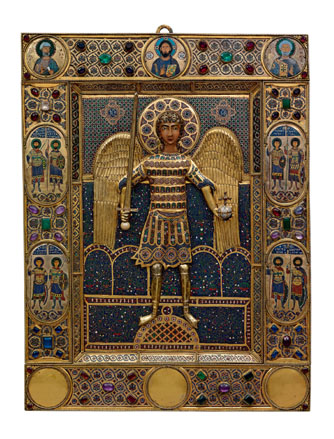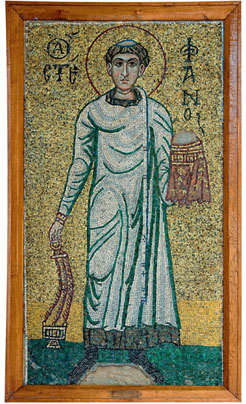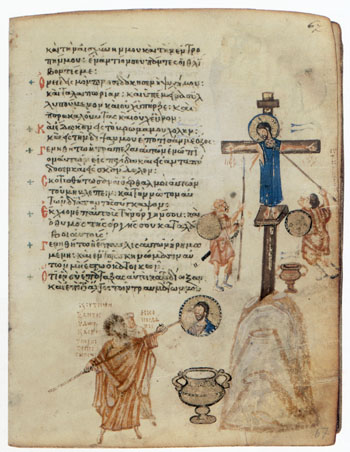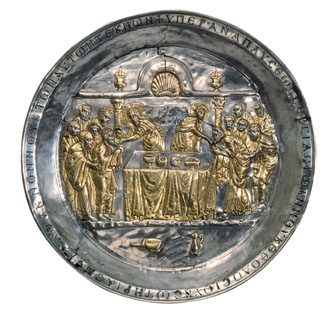 |
|
|
Major Exhibit Until 22 March at London's Royal Academy of Arts: |
|
|
From October 2008, the Royal Academy of Arts has been hosting a ground-breaking exhibition devoted to Byzantium. Supported by the J.F. Costopoulos Foundation, the A.G. Leventis Foundation, and the Stavros Niarchos Foundation, the exhibition will run until March 22, 2009 in London. Highlighting the splendours of the Byzantine Empire, the exhibition comprises around 300 objects including icons, detached wall paintings, micro-mosaics, ivories, enamels plus gold and silver metalwork. Some of the works have never been displayed in public before. "Byzantium 330–1453" includes great works from the San Marco Treasury in Venice and rare items from collections across Europe, the USA, Russia, Ukraine and Egypt. The exhibition begins with the foundation of Constantinople in 330 AD by the Roman Emperor Constantine the Great and concludes with the capture of the city by the Ottoman forces of Mehmed II in 1453. This is the first major exhibition on Byzantine Art in the United Kingdom for 50 years. |
 |
|
"Byzantium 330–1453" follows a chronological progression covering the range, power and longevity of the artistic production of the Byzantine Empire through a number of themed sections. In this way the exhibition explores the origins of Byzantium; the rise of Constantinople; the threat of iconoclasm when emperors banned Christian figurative art; the post-iconoclast revival; the remarkable crescendo in the Middle Ages and the close connections between Byzantine and early Renaissance art in Italy in the 13th and early 14th centuries. Between 1204 and 1261, Constantinople was in the hands of the Latin Crusaders, but the return of the Byzantine Emperors to the city initiated a final period of great diversity in art. Art from Constantinople, the Balkans and Russia show the final phase of refinement of distinctively Orthodox forms and functions, while Cretan artists like Angelos Akotantos signed their icons and merged Byzantine and Italian styles. Up to the end of the Byzantine Empire, with the fall of Constantinople to the Ottoman Turks in 1453, manuscripts, micromosaics and metalwork demonstrate the virtuosity of its artists. |
|
 |
 |
| (Images above: [left] Unknown artist, Mosaic icon of Saint Stephen, c. 1108–1113. Tesserae on stucco, 218 x 118 x 7 cm. National Conservation Area St. Sophia of Kiev; [right] Unknown artist, The Khludov psalter, 857–865. Parchment, ink, cinnabar, gold painting, tempera, wood and leather, 21 x 17.5 x 6 cm. The State Historical Museum, Moscow, Russian Federation, GIM 86795 Khlud. 129, fol. 67r. Photo © The State Historical Museum.) The exhibition shows the long history of Byzantine art and documents the patrons and artists and the world in which they lived. Seeing themselves as the members of a Christian Roman Empire they believed that they represented the culmination of civilisation on earth. The art emits an intellectual, emotional and spiritual energy, yet is distinctive for the expression of passionate belief and high emotion within an art of moderation and restraint. |
|
 |
"Byzantium 330-1453" showcases the Antioch Chalice, 500–550AD, on loan from the Metropolitan Museum of Art, New York. After its discovery in c.1911, the silver gilt artefact was believed to have been the Holy Grail, the cup used by Christ at the Last Supper. Major works from the Treasury of San Marco, Venice have been loaned to the Royal Academy including the ornate Chalice of the Patriarchs, c. 10th–11th century. Other highlights include a two-sided icon of Virgin Hodegetria (obverse) and the Man of Sorrows (reverse), 12th century, from the Byzantine Museum, Kastoria, an impressive 10–11th century imperial ivory casket from Troyes cathedral depicting hunting scenes and riders and the Homilies of Monk James Kokkinobaphos, a manuscript from 1100–1150AD on loan from the Bibliotheque Nationale de France, Paris. "Byzantium 330–1453" continues the RA’s tradition of hosting outstanding exhibitions exploring world cultures, which have included "Africa: The Art of a Continent" (1995), "Aztecs" (2002), "Turks: A Journey of a Thousand Years" (2005) and "China: The Three Emperors, 1662–1795" (2006). (Image at left: Unknown artist, The Riha paten, 565–578. Silver with gilding and niello, Diameter 35 cm. Byzantine Collection, Dumbarton Oaks, Washington, DC. Photo © Dumbarton Oaks, Byzantine Collection, Washington, DC.) |
|
ORGANISATION SPONSORS The J.F. Costopoulos Foundation, the A.G. Leventis Foundation, and the Stavros Niarchos Foundation are very proud to support the exhibition "Byzantium 330-1453." The three foundations are committed to promoting and preserving Hellenic culture and heritage in Greece and abroad. Furthermore, the foundations aim to express their active support for collaborative projects between acclaimed international institutions, realised in this case by the Benaki Museum in Athens and the Royal Academy of Arts in London. The J.F. Costopoulos Foundation, the A.G. Leventis Foundation, and the Stavros Niarchos Foundation have a long tradition of supporting major exhibitions of Byzantine Art and hope that, through their collaboration with such renowned cultural organisations, they will enhance the audience’s understanding of a very significant culture. CATALOGUE The exhibition is accompanied by a magnificent catalogue illustrated with over 340 works and with contributions from more than 100 authors. In thirteen essays, leading authorities trace the history and cultural development of more than a thousand years of Byzantine art, revealing the splendours of the imperial city of Constantinople. DATES Press View: Tuesday 21 October 10am – 2pm ADMISSION £12 full price; £10 Registered Disabled and 60 + years; £8 NUS / ISIC cardholders; £4 12–18 years and Income Support; £3 8–11 years; 7 and under free. TICKETS Tickets are available daily at the RA. To book tickets in advance please tel: (+44) 0870 848 8484 or visit the museum's website at http://www.royalacademy.org.uk. Groups of 10 or more are asked to book in advance; please telephone: (+44) 020 7300 8027, fax: (+44) 020 7300 8084 or email: groupbookings@royalacademy.org.uk |
|
|
(Posting date 16 March 2009) HCS encourages readers to view other articles and releases in our permanent, extensive archives at the URL http://www.helleniccomserve.com/contents.html. |
|
|
|
|
2000 © Hellenic Communication Service, L.L.C. All Rights Reserved.
http://www.HellenicComServe.com |
|
